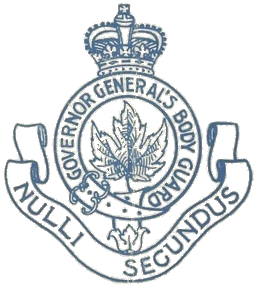
The Royal Canadian Hussars (Montreal) (abbreviated as RCH) is an armoured reconnaissance regiment of the Primary Reserve in the Canadian Armed Forces. It is one of the oldest cavalry regiments in North America, tracing a direct history to the Montreal Volunteer Cavalry formed in the late eighteenth century. Its Colonel-in-Chief is Her Royal Highness, the Princess Royal, and its allied regiment is the Queen's Royal Hussars. Its mission consists of supporting the Regular Force in operational deployments, peacetime tasks, and supporting the civilian authorities.

The Governor General's Horse Guards is an armoured cavalry regiment in the Primary Reserve of the Canadian Army. The regiment is part of 4th Canadian Division's 32 Canadian Brigade Group and is based in Toronto, Ontario. It is the most senior reserve regiment in Canada, and the only household cavalry regiment of Canada's three household units.

The Governor General's Body Guard was a royal guard regiment of the Canadian Army that formed part of the country's household troops. The Body Guard was the senior regiment of the Canadian Army and the equivalent of the British Army's Life Guards and Royal Horse Guards. In 1936 the regiment amalgamated with the Mississauga Horse to become The Governor General's Horse Guards.

The 4th Princess Louise Dragoon Guards is an inactive armoured regiment of the Canadian Militia / Canadian Army. It is currently on the Supplementary Order of Battle.

The 8th Canadian Hussars (Princess Louise's) (VIII CH) is a reserve armoured reconnaissance regiment in the Canadian Army, with two squadrons. It was formed on 4 April 1848 in the then-colony of New Brunswick, which remains the regiment's home to this day, its regimental headquarters (RHQ) and A Squadron being in Moncton, with B Squadron in Sussex.

Dragoon Guards is a designation that has been used to refer to certain heavy cavalry regiments in the British Army since the 18th century. While the Prussian and Russian armies of the same period included dragoon regiments among their respective Imperial Guards, different titles were applied to these units.

The 2nd/10th Dragoons was a militia regiment of the Canadian Army, based in the Niagara, Wentworth, and Brant regions of southern Ontario. It was formed in 1936 by amalgamating the 2nd and 10th Dragoons, both of which had served previously as cavalry units in the Canadian militia. After World War II the regiment was converted into an anti-aircraft artillery unit. In 1962 the regiment was converted into a field howitzer unit and in 1968, amid a downsizing of the Canadian Armed Forces, the regiment was reduced drastically before eventually being completely disbanded in the mid-1990s. The regiment is currently on the Supplementary Order of Battle.
The 15th Canadian Light Horse was a light cavalry regiment of the Non-Permanent Active Militia of the Canadian Militia. First formed in 1905 as the 15th Light Horse, the regiment was redesignated in 1920 as the 15th Canadian Light Horse. In 1936, the regiment was Amalgamated with The South Alberta Horse to form the 15th Alberta Light Horse.
The 10th Brant Dragoons was a cavalry regiment of the Non-Permanent Active Militia of the Canadian Militia. First raised in 1909 as the 25th Brant Dragoons, the regiment was redesignated in 1921 as the 10th Brant Dragoons. In 1936, the regiment was amalgamated with the 2nd Dragoons to form the 2nd/10th Dragoons – now part of the 57th Field Artillery Regiment, RCA.
The 6th Duke of Connaught's Royal Canadian Hussars was a light cavalry regiment of the Non-Permanent Active Militia of the Canadian Militia. First formed in 1855 as an independent cavalry troop, in 1879 it became a full regiment and was the oldest cavalry regiment in Montreal. In 1958, the regiment was amalgamated with the 17th Duke of York's Royal Canadian Hussars to form The Royal Canadian Hussars (Montreal).
The 5th Dragoons was a cavalry regiment of the Non-Permanent Active Militia of the Canadian Militia. In 1901, the regiment was amalgamated with the 6th Duke of Connaught's Royal Canadian Hussars – today now part of The Royal Canadian Hussars (Montreal).
The King's Canadian Hussars were a cavalry regiment of the Non-Permanent Active Militia of the Canadian Militia. In August 1939, the regiment was converted to artillery and currently exists today as the 87th Field Battery, RCA.
The 2nd Dragoons was a cavalry regiment of the Non-Permanent Active Militia of the Canadian Militia. In 1936, the regiment was Amalgamated with the 10th Brant Dragoons to form the 2nd/10th Dragoons – today now part of the 57th Field Artillery Regiment, RCA.
The 3rd Prince of Wales' Canadian Dragoons was a cavalry regiment of the Non-Permanent Active Militia of the Canadian Militia. In December 1936, the 3rd Dragoons were amalgamated with The Peterborough Rangers to form The Prince of Wales Rangers.
The British Columbia Hussars was a light cavalry regiment of the Non-Permanent Active Militia of the Canadian Militia. In 1939, the regiment was converted from light armour to artillery.
The Haldimand Rifles was an infantry regiment of the Non-Permanent Active Militia of the Canadian Militia. In 1936, the regiment was Amalgamated with The Dufferin Rifles of Canada to form The Dufferin and Haldimand Rifles of Canada.
The Frontenac Regiment was an infantry of the Non-Permanent Active Militia of the Canadian Militia. In 1936, the regiment was converted from infantry to artillery and now exists as part of the 33rd Medium Artillery Regiment, RCA – currently on the Supplementary Order of Battle. The regiment was named for Frontenac County.
The 33rd Medium Artillery Regiment, Royal Canadian Artillery was an artillery regiment of the Canadian Army Reserve based in Cobourg, Ontario. In 1965, the regiment was reduced to nil strength and placed on the Supplementary Order of Battle.
The Princess Louise Dragoon Guards was a heavy cavalry regiment of the Non-Permanent Active Militia of the Canadian Militia. First formed in 1872 as an independent cavalry troop, in 1903 it became a full regiment. In 1936, the regiment was amalgamated with the 4th Hussars of Canada to become the 4th Princess Louise Dragoon Guards.






